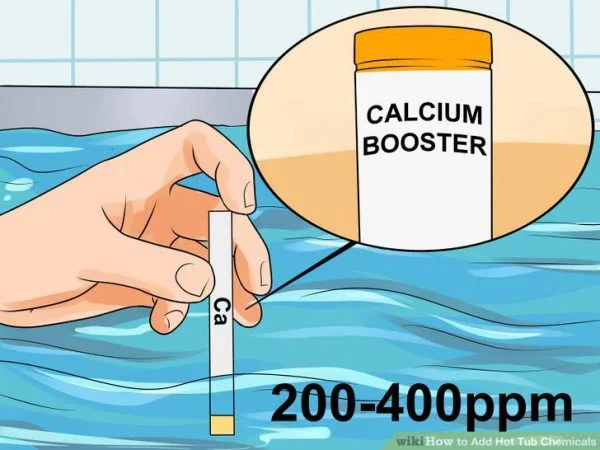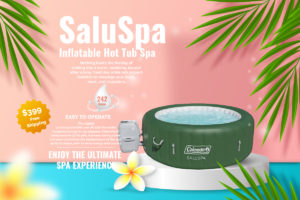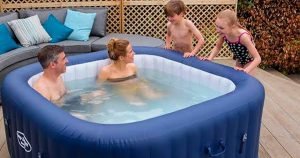Hot Tub Spa or Hot Tub Pool: Understanding Your Calcium Levels

Why Calcium Matters in Your Hot Tub
High in naturally occurring minerals such as calcium, which makes your water “hard”. Balancing calcium hardness is a significant part of the water chemistry in hot tubs. It makes the water clear, fresh and odor free while stoping build up on the spa’s surface and equipment.
Calcium is found naturally in metals like iron or copper, doesn’t change the water color like they do, but its imbalance can create just as much trouble. The recommended calcium reading for the majority of hot tubs is between 80–200 PPM. The exact amount might vary depending on your water source and type of hot tub.
When calcium levels drop too low, your spa water may become corrosive, eventually causing damage to the hot tub shell and internal components over time. Alternatively, you can get too much calcium in the water (over 400 PPM) and that can contribute to cloudy water, scum line formation and scale.
It’s easy to test calcium hardness with a basic water test kit. If that is the case, treating your hard water with mineral treatment products or a magnetic water conditioner may help. These appliances produce a slight electrical charge to help minimize scale from forming as your spa system processes water.
Dealing with Soft and Hard Water Situations
For those of us residing in naturally soft-water regions, calcium hardness may not appear to be a major concern — but it is. Balancing your pH and alkalinity will also keep soft water from getting too corrosive.
Soft water can cause:
- Shell or equipment damage
- Excess foam formation
Among the steps you can take to avoid a white line: Regularly test your water and, if calcium is low, add a calcium hardness increaser in accordance with the product’s instructions. Between 150–200 PPM is the best range for most hot tubs.
How to Add Calcium to the Hot Tub
If your calcium levels are low, you can supplement with either liquid- or granular calcium. Both work equally well — but most folks prefer liquid because it measures easily.
It’s best to start by filling it with soft water and add calcium increaser as needed. Just one application of Foam Down will eliminate that foamy residue on the top of your spa and the best part is, a regular does of scale control can prevent this buildup so water looks crystal clear.
The relatively high calcium hardness also means that maintaining good pH (7.2–7.6) and total alkalinity (in the neighborhood of 100 PPM) balance is even more crucial here, so don’t skip these steps either. You may need more “pH down” product than usual to get into that range. Once balanced, you can safely and comfortably enjoy the clean water of your spa.

How to Get Rid of Heavy Metals in Hot Tub Water
Why Heavy Metals Are Bad
Heavy metals such as iron and copper are also the among water quality challengers. Their presence varies depending on your local water source — particularly if you’re drinking well water.
Signs you have high heavy metal levels in water:
- A greenish tint in the water
- Staining on the Hot Tub Interior Shell
- Ways to know your spa is overdue for a calcium treatment earnest-indications Signs Your Spa Needs Calcium Treatment Scale deposits on the surface of spa
Left unchecked, they will get permanently stuck to the surface, clog your heater, and reduce efficiency in your spa.
Solutions For Heavy Metal Imbalance
Warm the Water
Get your hot tub water to a nice warm, temperature – around 80°F. Warm water allows granular chemicals to dissolve more efficiently.
Balance the pH
Check the water and adjust the pH to between 7.6–8.2 with either “pH up” or “pH down”. Have it strain for 30 minutes or so before retesting.
Add Treatment Chemicals
Add 1 x capful of stain and scale controller and 1 x tuo (cap only) water clarifier. You can also put 2 oz of enzyme product which will help remove scum and odors from body oils or make-up.
Adjust Alkalinity
You want total alkalinity to be around 100 PPM. Add an alkalinity increaser or decreaser, if necessary.
Maintain Balanced Water Levels
Remember — pH, calcium hardness, alkalinity and heavy metals are interconnected. You can’t fix one and forget the rest. Regularly test and balance all four if you want to keep your hot tub safe, clean, and in good shape.
Healthy water is the key to the hot tub experience you love — relaxing massage and crystal-clear, bromine-free water with fewer chemicals and less effort.





